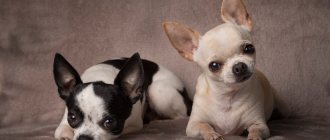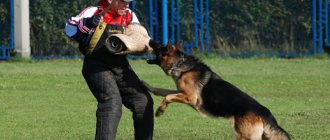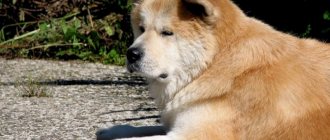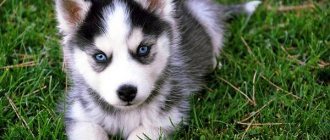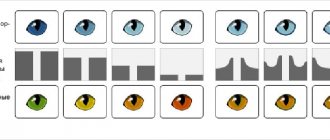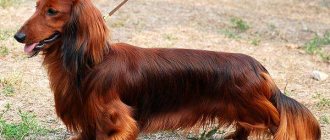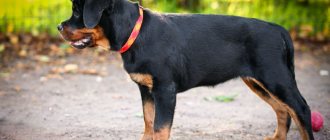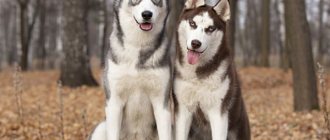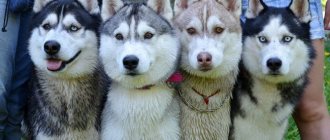Huskies have long won the world's love and trust. This is a friendly, hardy and very athletic breed with a relatively compact build. Dogs are able to build strong relationships with their owners, making them true friends for life. Today I would like to tell you about how to properly care for a husky and what nuances in care and maintenance should be taken into account first of all.
Huskies, however, like any other dogs, need comfortable conditions. Agree, without this it is impossible to raise a healthy and happy pet. The convenience of this breed lies in the fact that huskies can be kept both on the street and at home in an apartment. However, it is worth remembering that it is not advisable to put them on a chain.
Husky care
Huskies are hardy dogs with good health. If you take proper care of your pet, it can live up to 20-25 years. However, many owners do not follow the rules of care, which is why the husky begins to feel sad and has health problems. For example, some dog breeders forget that this breed was bred to ride sleds. Therefore, regular physical activity is an essential part of a husky's life. Being locked up all day long makes the dog feel unhappy. We will talk about other rules for caring for a husky later.
How to care for a husky: a matter of nutrition
Let's start with how often you need to feed individuals of different ages.
- Up to 2 months – six times a day.
- From 2 to 4 months – five times a day.
- From 4 to 6 months – four times a day.
- From 6 to 10 months – three times a day.
- From 10 months to 1.5 years – 2 times a day.
- Adult dog – 1-2 times a day.
You have a choice: feed your dog regular, “human” food or buy ready-made food.
If you plan to feed your husky regular food, remember that meat should make up 50-60% of the diet. The most preferred option is beef. Rabbit and turkey work well. Be careful with the chicken. It causes allergies in many individuals. If you decide to give your dog chicken, carefully monitor its health. If you detect the slightest problems with skin, coat, eyes, or general well-being, reconsider your diet. Huskies are prohibited from feeding lamb and pork. Give the meat lightly cooked or raw.
You can give your dog egg yolks 1-2 times a week. They can be either cooked or raw. You can add fermented milk products to your diet. It is better to feed your husky cottage cheese or kefir than raw milk, as it may give your pet an upset stomach. It is allowed to feed the dog vegetables. The exception is potatoes. A good option is porridge: for example, rice, oatmeal, buckwheat. Add a little vegetable (olive, sunflower, pumpkin, sesame, hemp) oil or fish oil to your food. It is strictly forbidden to give your dog peanut butter, cocoa butter, coconut oil, cottonseed oil and palm oil. Butter should also not be added to the diet, as it harms the animal’s liver.
Don't forget about vitamins. They support the husky’s immune system, improve the condition of the skin, coat, and eyes. Ask your veterinarian about what vitamins you should give your dog and in what quantity.
If you decide to feed your pet store-bought food, you should not save too much. Cheap feeds contain raw starch. This component is difficult for the husky's body to tolerate.
Puppies under 10 months of age should be given special puppy food. Important! Switch to the “adult” version no later than ten months. Otherwise, your husky may develop hip dysplasia. Choosing the right food for this breed is a difficult task. A dog may have individual characteristics that do not allow it to eat a particular food. Monitor your pet's health after eating food.
As for adults, it is better to give preference to food for active dogs. Let us remind you: Husky is a breed that has a craving for physical activity. In order for the body to allow the dog to run and play as much as possible, it needs to be saturated with proteins and healthy fats. Specialized feeds have all this. You can give your husky both dry and wet food.
If you have any questions regarding your animal's nutrition, please contact your veterinarian. A specialist will select the right food and vitamins. This way, you won't need to experiment with your pet's health.
When not to use the tool
Despite its advantages, the accessory also has a number of contraindications. Restrictions on use are imposed if the coat type is unsuitable and in the presence of certain diseases or injuries.
Breeds that should not be scratched with a furminator
It is prohibited to comb animals with long, thin and silky hair, such as lapdogs, Yorkies, Shih Tzus and Afghan hounds. Blades of such great length are simply not available.
Also, you should not use the tool if the dog has curly and rough fur (poodles, Airedales, Komondors). When combing, it catches and smoothes the hairs, removing the curls inherent in the breed.
The main task of the product is to remove undercoat. For this reason, it is simply pointless to use it for combing smooth-haired (dachshunds, bulldogs, Dobermans) and completely hairless (Chinese Crested, Peruvian dogs) breeds.
Temporary contraindications
Temporary contraindications include multiple tangles, any damage to the skin and dermatological diseases. If your pet is injured or suffers from eczema, postpone brushing until it recovers. Otherwise, you will only hurt him and make the existing problem worse.
Caring for a Husky in the Heat
Although this breed was bred in the cold northern regions, the dog can withstand hot summers without harm. Huskies have a thick undercoat that absorbs heat from direct sunlight. As a result, the dog's body temperature does not change much.
However, there is a second side to the coin. During serious physical activity, heat comes from the dog’s body. It is difficult for the same undercoat to pass through (this is also why huskies do not freeze during severe frosts). As a result, the sun gives its dose of heat, and the body - its own. This greenhouse effect creates discomfort for the husky and is dangerous. Therefore, during the heat, you should not put too much stress on your pet. Also, make sure your dog always has access to water.
What is it intended for and who is it suitable for?
The tool is designed to prevent tangles and reduce the duration of seasonal shedding. It quickly removes accumulated fluff without causing pain or discomfort to the animal.
The device is suitable for breeds with a thick and well-developed undercoat:
By combing out excess hair, natural heat exchange is maintained and new hair growth is stimulated. This eliminates overheating in hot weather or hypothermia in the cold season.
Husky coat care
The coat of dogs of this breed cleans itself, as a result of which the dog needs to be bathed very rarely. Thanks to the ability to self-clean, wool does not emit an unpleasant odor. In short, caring for your pet's fur consists almost entirely of brushing it. To effectively carry out this procedure, you need to acquire the following devices:
- slicker;
- medium tooth brush;
- crest.
During the period between shedding, the dog should be brushed at least once a week. As a result, the coat will be shiny, smooth and free of unsightly lumps. During the molting period (autumn-spring), a dog needs to be brushed at least once a day. If you live in an apartment, twice a day. First, the exposed undercoat is removed. A powder brush is used for this. Next comes combing with a brush and comb. Particular care should be taken to comb the fur between the ears, on the back of the legs, on the front legs and tail. No need to make sudden movements. Scratch with and against the fur.
Puppies under 6 months of age need to be groomed differently, as their coat is still too soft and fragile. Use a special soft brush, which can be purchased at pet stores.
As mentioned above, huskies need to be bathed rarely - 2-3 times a year. If the dog's coat is clean, water procedures can be performed even less frequently. The fact is that too frequent bathing disrupts the fat balance of the animal’s skin. The result is discomfort and an unpleasant odor.
The use of human bathing equipment is prohibited. Use only dog shampoos and conditioners. If your husky is still afraid of a hair dryer, dry him with a regular towel. In the future, you can dry the wool using a hair dryer at low temperature. After bathing, it is better to comb the dog so that the coat retains its beautiful appearance.
Washing paws is not considered a full bath. This procedure can be carried out after each walk. It is worth starting from an early age, as an untrained dog may resist in the future.
Views from photos
For combing wool
Long, fluffy hair is an adornment of many breeds. But in order for it to look perfect, the dog must be thoroughly combed. This procedure will not harm wire-haired dogs and even pets with short and smooth hair.
Furminator
This modern device replaces a number of dog grooming procedures. It looks like an instrument with a wide base and one row of straight and closely spaced teeth. The Furminator can quickly remove loose fluff in one go.
How to use a furminator for dogs: you need to gently and without excessive effort run it over the dog’s body, collecting fallen hairs. As necessary, the furminator is cleaned of combed wool.
This tool has many advantages. In addition to the fact that it is reliable and durable due to the strength of the teeth, the furminator has another advantage: when combing, it does not cause anxiety to the dog; on the contrary, pets like this procedure.
The Furminator is suitable for both long-haired and smooth-haired breeds. The only condition for its successful use is that the dog has undercoat, which is removed with this tool.
For long-haired dog breeds, a furminator with longer teeth is needed, and for short-haired dogs, one with shorter teeth. For a medium-haired pet, you should choose an intermediate option.
Perhaps the only serious drawback of the Furminator is its price. It is quite large and ranges from $30 for a small model to $70 for a large one.
Puhoderka
Before the invention of the furminator it performed its functions. But if furminators of different models are suitable for a variety of dog breeds, then only furry animals with a rich undercoat can be combed with a slicker brush.
What is a slicker? This is a rectangular comb-brush with curved wire teeth, which can easily be used to pick up loose undercoat and remove it.
How much does a slicker cost : its price does not exceed 800 rubles. There are also very cheap models: for 100-200 rubles. Professional slickers for groomers are more expensive, their cost reaches 1,500 rubles, but they are of better quality.
When choosing a slicker, pay attention to the size of the tool itself, as well as the length and stiffness of the wire “bristles”: all these parameters must correspond to the size of the dog and the length and thickness of the coat.
It is desirable that there are metal, rubber or plastic balls at the ends of the “bristles” of the slicker brush. Otherwise, there is a risk of injuring the dog.
A brush with a drop is the best and most “gentle” option!
Crest
Necessary for the final combing of long-haired dogs, such as Spitz, to remove loose hair that the slicker can no longer capture. Even from a pet’s fur that seems perfectly combed at first glance, it will pull out some more fallen fluff, which, if it had remained in the fur, could have become tangled. Only a comb can comb thick wool well, and it also lifts the hairs at the roots, creating visual volume.
The comb is suitable for: Samoyeds, all Spitz dogs, huskies, malamutes and other dogs with an “arctic” type of coat, that is, one with a thick undercoat and rough outer coat.
A comb for dogs is chosen based on the size of the animal, the length and thickness of the coat, but it is better to choose a model with teeth of different lengths: such a comb will comb both the guard hair and the undercoat. It is recommended to use a comb for daily grooming of your dog's coat.
The cost of a high-quality comb for dogs does not exceed 1000 rubles, but there are cheaper models.
Massage brush
There are several types. The two most common ones are in the form of a brush with a handle and one that is put on the hand and secured with straps. The bristles can be either natural or made of plastic or metal; in the latter case, it is desirable that there are droplet-shaped balls at the ends of the “bristles”: they will prevent injury to the pet’s skin when combing.
The main purpose of this brush is not so much to comb, but to style and even smooth the dog’s fur, while simultaneously providing a light massage. It is suitable for dogs with smooth and short hair, since it will not be possible to thoroughly comb long fur with a rich undercoat.
When choosing, you should pay attention to the quality, length and frequency of the bristles. A massage brush that fits on your hand allows you to comb the fur in hard-to-reach places better than a brush with a handle.
The price range for such combs is wide. The cheapest ones can be purchased for 100 rubles, but there are also expensive ones, up to 2000 rubles or more.
Mitten
Designed for combing smooth-haired dogs . It looks like a mitten, complete with spikes. Often the “spike” pad is made of rubber, less often it is plastic. Some combs of this type have a pad that looks like a metal or plastic massage brush. It’s easy to use: you just need to put the comb-mitten on your hand and run it through your pet’s fur. Dogs favor this procedure, as it is also a good massage for them.
You can use this comb every day: it does not injure your pet’s skin or fur.
Suitable for short-haired and smooth-haired breeds with almost no undercoat, such as Great Dane, Boxer or Pinscher.
When choosing a mitten, you should focus on the hardness of the spikes: they should be neither too hard nor too soft. Also, the mitten should “sit” comfortably on your hand.
The cost of this comb is not too high: it ranges from 200 to 800 rubles.
Glove
Its functions are similar to a comb-mitten, the only difference is that its spines are smaller and located over the entire surface, even on the fingers. The outer side is made of thick fabric, it is equipped with a Velcro fastener, thanks to which the glove fits perfectly on the hand.
Its advantage is that it can be used to comb the hair not only on the back or sides of the dog, but also in more delicate places.
This glove is suitable for long-haired and medium-haired breeds. It collects dead hair well from the entire surface of the pet’s body without causing him any disturbance.
The cost of such a comb is small: 150-200 rubles.
Rotating tine rake
It looks like a rectangular brush with teeth. The peculiarity of this tool is that each of the teeth is not fixed in the socket, but rotates freely. This allows you to collect more dead hair when combing, which reduces the amount of wool on the owners’ clothes, carpets and furniture.
You need to comb your dog with it as with a regular comb, both according to the growth of the coat and against it. This comb is used as needed. Suitable for medium-haired and long-haired dogs with a thick undercoat: such as Malamute, Keeshond, Samoyed, Caucasian Shepherd or Collie.
For combing out fleas
It is a plastic base into which fine metal teeth are inserted. Designed to completely rid the dog of external parasites. Thanks to the minimum distance between the teeth, it combs out those insects that could not be removed during washing.
Suitable for all breeds of dogs, but when choosing, you need to proceed from the size of the pet and do not take a small flea comb for a large dog, as it will not comb his fur, and it is not comfortable to use. A small dog should also not be treated with a large “comb”: it is inconvenient to use and besides, it can easily injure a small dog.
The cost of such a tool is relatively low: in online stores you can buy one for 500 rubles or a little more.
For haircut
When grooming dogs, a comb is used to comb the hair, divide it into several parts, and use it to trim the edge of the dog’s “hairstyle.” There are also comb-trimmers, which, in fact, are more like clippers.
Metal
It is a comb with teeth of the same length. It is needed as an auxiliary tool when grooming dogs; its task is not to comb the hair, but to divide it into strands and smooth it. Using a long metal comb is convenient for smoothing the hair along the bottom of the “skirt” of dogs such as Yorkshire or Maltese.
Needed by owners of grooming dog breeds , such as poodle, bichon, yorkie, and bedlington terrier. But it can also be useful for those whose pets are dogs with long hair, such as Shih Tzu or Pekingese.
When choosing a metal comb, you need to focus on its size and frequency of teeth: for dogs with undercoat, a more frequent metal comb is needed, and for animals with long, straight and smooth-lying hair, less frequent, so as not to damage the coat.
The cost depends on the size of the instrument and its quality and ranges from 500 to 1500 rubles.
Trimmer
Externally, trimmers are similar to dog clippers. They come in several types: rotary, vibration, pendulum and battery. When trimming animals, rotary or cordless trimmers are usually used. Vibrating ones are used less often because they are low-power and the knives in them are difficult to change. Rotary ones, as the most reliable, are used when grooming dogs with thick hair.
The trimmer kit usually includes several metal comb attachments, differing in size and with teeth of different lengths. It is not difficult to work with them, but at first it is unusual, especially for a person who has taken such a tool in his hands for the first time.
Trimmers are suitable for those breeds of dogs that require a haircut, and the owner wants to tidy up his dog’s fur himself.
The price of a trimmer depends on the quality of the tool and the materials from which it is made. The type of trimmer also plays a significant role in pricing. On average, their prices start from 1200-1500 and reach 3000 or more.
You need to choose a trimmer so that it suits the size of the dog and the length of its coat. And one more thing: it is better to avoid overly cheap models, since this is exactly the case when the stingy pays twice. A low-quality trimmer bought on the cheap will soon break and need replacement. Of all types, it is better to give preference to rotary or battery.
For trimming
Stripping
It looks like a rectangular brush, but in fact it consists of several blades connected together and mounted on a wooden handle. Stripping is used to quickly and easily remove lost hair.
There are several types of strippers, differing from each other in the size, length and shape of the blades. They are mainly used for trimming wire-haired breeds , such as most terriers or schnauzers. But there are also strippers for dogs with soft and slightly wavy hair, such as cocker spaniels.
Strippings are chosen based on the pet’s coat type and size. Preference should be given to models with blades made of high-quality steel, otherwise there is a risk that the tool will quickly break.
The process of stripping a dog is similar to regular combing. Only in this case you need to properly pull the fur so as not to accidentally injure the dog.
Strippers should be used only when necessary, during trimming . There is no need to use them to simply remove lost hair: there is a risk of either removing excess hair or injuring your pet.
Prices for strippers are not too high, they start from 1000 rubles for small models to 1500 for large ones.
Metal with wooden or plastic handle
Before processing the wool by stripping, as well as during the trimming process, the dog’s fur is combed in order to better see the result of the treatment, and at the same time to remove the hair combed out by stripping.
For this procedure, you can use any convenient wide-toothed comb.
This comb is used both as an auxiliary tool during trimming and for daily combing of the dog.
The cost of a metal comb mounted on a plastic or wooden handle is low: about 100 rubles.
For grooming
Spoke
Can be metal or plastic. The main distinguishing feature is a narrow long handle, similar in shape to a rapier blade with a sharp, tapering end. Using this comb, you can simultaneously comb the dog with the toothed part while grooming, and use the end of the handle to make partings or twist the hair onto it, then placing it in curlers or making a top note.
Suitable for most “hairdressing” breeds that receive complex haircuts, and, first of all, poodles.
The price range for these combs is wide. An inexpensive model can be purchased for 200-250 rubles; for a more expensive one you will have to pay about 1000 rubles.
Groomer
The groomer comb looks similar to a stripper and also has the appearance of several blades gathered together and attached to a handle. The groomer differs from the stripping comb in the shape of its blades: while the stripping comb has Y-shaped blades, the groomer's blades look like hooks curved downward.
Necessary for cutting and combing neglected, matted wool. This tool carefully cuts off small tangles and combs the fur along with the undercoat.
Suitable for long-haired and wire-haired breeds. Treat animals with it as needed; it is not suitable for frequent use.
When choosing, pay attention to the quality of the material from which the blades are made. The cost of a grooming comb is approximately 1000 rubles.
Colt cutter
Anti-matt comb. It looks like a fine-toothed comb with a handle, but instead of teeth this comb has blades. This tool is designed to gently untangle and cut tangled wool.
Used for professional grooming of long-haired dogs.
When choosing a tangle comb, you should give preference to models with a high-quality stainless steel blade with a comfortable handle.
The cost of such a tool depends on the quality, manufacturer and materials from which it is made; it starts from 400-500 rubles and above.
With blade
It looks like a regular comb with a blade inserted inside it. Designed for thinning wool when cutting and partially shortening it.
It is used when grooming dogs of those breeds whose standard requires thinning the coat, that is, this tool can be some kind of alternative to more expensive stripping.
The cost depends on the model; the simplest combs with blades (though not dog combs, but rather universal ones, suitable for both people and animals) can be bought for less than 100 rubles.
Which one is the most professional?
The best of professional combs can be considered stripping . It not only quickly removes dead undercoat, but also allows you to very quickly form clear lines when cutting and trimming dogs.
Also a very good and truly necessary tool for a professional groomer is a knitting comb , without which it is impossible to make a beautiful top note or parting.
grooming combs are most suitable for professionals .
Which one to choose for home?
At the moment, the most universal tool, suitable for both professionals and ordinary dog breeders, is the furminator . It allows you to very quickly rid your pet of the undercoat that has fallen out during shedding, and therefore is a true salvation for many owners. The Furminator can be selected for almost any dog, both long-haired and short-haired, which is also its undoubted advantage.
Husky paw care
Huskies are active animals that can “pick up” a lot of things on their paws in one walk. We strongly recommend washing them after each visit to the street. If you live in a private home and your dog spends time in the yard, wash its paws as they become dirty.
If your dog's paws are not too dirty (which happens after short walks), it is recommended to use regular cool water. Soap should be used in “severe” cases. Dog shampoo diluted in water in a ratio of 1 to 5 is excellent for washing paws. It is worth cleaning not only the pads, but also the space between them. After bathing, paws should be dried with a regular towel.
In the context of paw care, caring for a Husky in an apartment is more complex than in a country house. The fact is that a large amount of substances that harm the pads accumulate on city roads. This includes salt, settled exhaust, and dirt with impurities, which is carried by thousands of people. To protect your dog's paws, you can apply a wax ointment or paste to the skin. They can be purchased at pet stores. The product must be applied before walking. It creates a film that protects paws from irritation and the negative influence of temperatures. In addition, many ointments and pastes have a healing effect. After a walk, the product should be washed off.
You can also use dog boots to protect your paws. They protect not only from the above factors, but also from mechanical damage.
It is recommended to apply softening dog cosmetics to the skin of the paws every 3-4 days. It will protect against discomfort and irritation. Human means cannot be used. Firstly, they are not suitable in composition. Secondly, the dog will certainly lick off the harmful “chemicals”, which will attract it with its aroma. If it is not possible to get specialized products, you can use a small amount of vegetable oil. More difficult to obtain is goose fat.
During its races and games, your pet can damage its paw. Treat the resulting crack with a dog emollient antiseptic until complete healing. Apply the product 2-3 times daily. If the crack does not heal for more than a week, take your husky to the vet. The same must be done when stains appear.
In case of a shallow cut, you need to wash the wound and treat it with hydrogen peroxide. Over the next four to five days, it is necessary to treat the wound with an antiseptic: for example, a solution of furasol. If the injury is serious, of course, it is better to go to the vet after stopping the bleeding. If this is not possible, do the following: remove foreign objects from the wound, if there are any, treat with hydrogen peroxide, apply a liquid plaster. In the future, use an antiseptic. The dog may chew on the wound. In this case, you need to bandage it. Dog boots can be used to protect the wound while walking.
If your dog is licking a wound, do not stop it from doing so. Saliva contains a powerful antiseptic that promotes speedy healing. The exception is if you have just applied medicine to a wound.
Trim your nails regularly. This is especially true for huskies, who spend little time outside, and their claws do not wear off on the asphalt. As soon as they start to curl, trim them. To do this, you should purchase a dog nail clipper. Don’t skimp on this device: the better quality it is, the less discomfort the trimming procedure will bring to your pet. Remember one more rule: more often is better, but safer. Trim just a few millimeters, otherwise there is a risk of touching the vessel.
Comb brush
First, the husky's fur is treated with a slicker and then with a comb to make it attractive. The owner removes formed tangles and smoothes the hair. Veterinarians recommend using 2-sided combs, in which the teeth on both sides have different lengths. First, the undercoat will be combed out with a brush, and then the fur itself. A quality product has the characteristics listed below:
Models with alternating teeth arrangement show greater efficiency. They capture a larger volume of the dog’s hair.
The first place in the ranking is occupied by a two-row flea comb with 65 teeth. Received positive feedback from professional breeders and buyers. The wear-resistant metal case, complemented by an ergonomic handle, will withstand intense loads. Regularly treating your dog's hair will rid him of fleas and flea eggs. They are located on the skin or hair. The advantage of Hello PET 2465D is the presence of 2 parallel rows of fine teeth, which ensure complete processing of the undercoat.
Breeders recommend first brushing your Husky with a brush to remove any mats and matted fur that have formed. More attention is paid to the area at the base of the tail, withers, and around the ears. A simple recommendation will help make the procedure more pleasant for the animal. First, the comb is slightly moistened with lotion or spray against fleas and other parasites. The owner will not only restore the original characteristics of a healthy coat, but also rid the dog of uninvited guests. The durability of the product is ensured by stainless steel, which will withstand many years of use.
On a note! Plastic combs accumulate static charge. There is a high risk that your pet will feel uncomfortable during the procedure.
Source
Husky ear care
It is recommended to examine your ears every day. However, you shouldn't clean them every day. There should be some dark brown sulfur inside. It protects your ears from dirt. Therefore, if you remove wax frequently, you will deprive your Husky of his natural shield.
You should clean your ears every 2-3 weeks. If there is too much sulfur, once a week. You can use either a dry cotton swab or a swab with a small amount of baby oil. A corner of a terry napkin works great. Puppies may resist, so it is better to use a cotton swab. Otherwise, the tampon may slip out of your hands and remain in the ear, which can lead to a difficult removal process.
There is no need to overdo it with prevention. Hydrogen peroxide is used only for diseases. The product may irritate healthy skin. The same applies to antiseptic and anti-inflammatory drugs. It is worth using anti-ear mite products for preventive purposes only after treating your Husky for fleas.
When to contact a veterinarian:
- the ear “squelches”;
- the skin inside became red;
- the pet constantly scratches its ear, this prevents it from sleeping;
- unpleasant smell from sinks;
- swelling, compaction;
- discharge (but not sulfur);
- the dog flinches when the ear is touched;
- An ear mite was spotted inside.
If your dog likes to swim in bodies of water, treat the ears with a special powder before each “water session”. After this, remove the product with a dry cloth. Read the instructions for more details on using the powder.
Caring for a pregnant husky
Typically, a Husky's pregnancy lasts 60-63 days. Due to individual circumstances, the period may be reduced to 58 days or extended to 72 days. It is worth preparing for childbirth from the 50th day. It is necessary to acquire medical supplies for obstetrics, organize an enclosure, and also minimize the amount of protein in the husky’s diet. A drop in body temperature of one degree indicates that a dog will give birth in the next 24 hours.
During pregnancy, the following rules must be observed:
- In the first 3 weeks after mating, significantly reduce physical activity. Most often, after this period, the husky itself continues to observe the “economy mode”, although it all depends on the character of the expectant mother;
- Take your dog out into the fresh air several times a day;
- increase the amount of vitamins. Veterinarian consultation is required;
- minimize the number of jumps;
- Treat your dog with care: no pushing, hitting, falling or other harsh physical impact.
When to contact a veterinarian:
- increased body temperature;
- toxicosis after 35 days of pregnancy;
- yellow, green, red discharge from the loop;
- aggressive behavior of husky;
- anxiety.
If you care for a pregnant husky correctly and there are no complications, the birth will take place quickly and with minimal human intervention.
Caring for a Husky after birth
Dark red discharge from the loop for two to three weeks after birth is normal. If the shade is different, or an unpleasant odor appears, you should consult a doctor as soon as possible. These are signs of inflammation of the uterus.
While the husky is feeding the puppies, do not use dog cosmetics or chemical protective agents. They can poison puppies. Full bathing for a new mother can be done five to seven weeks after giving birth.
Inspect the nipples of a nursing husky. If they are damaged, trim the baby's claws on the front paws.
In the case of a small number of offspring, the mother’s mammary glands may become denser. In this case, firstly, you need to massage these glands. Secondly, direct the puppies to those nipples near which there is a lump.
In the first three days, the mother's diet should consist only of dairy products. In the period from 3 to 5 days, you can give boiled meat and broth. After the fifth day, it is allowed to feed the husky raw meat. A week after giving birth, you can feed your dog puppy food and her regular diet. As a supplement, mineral supplements are used that are beneficial for the skeleton of puppies. If babies develop diarrhea after a certain food, remove it from the diet. You need to monitor not only the mother, but also the offspring.
